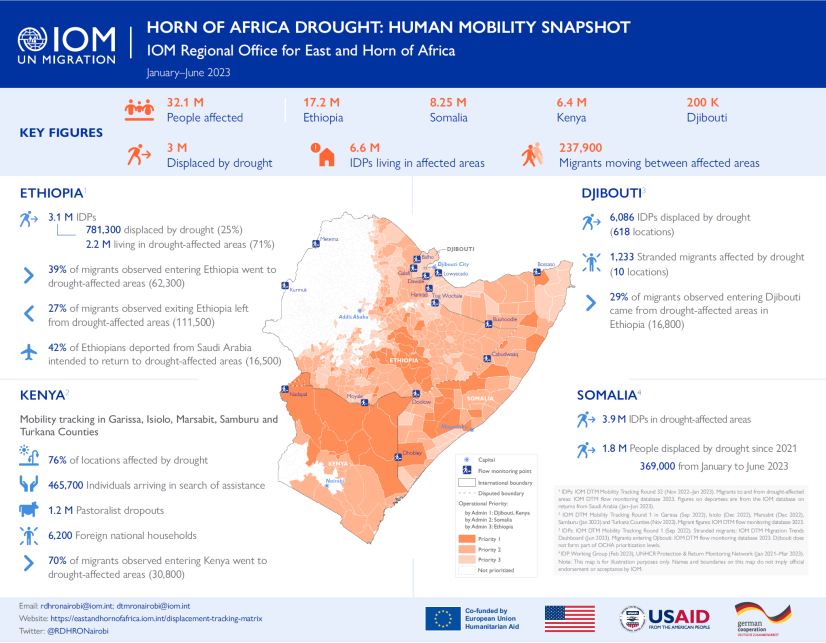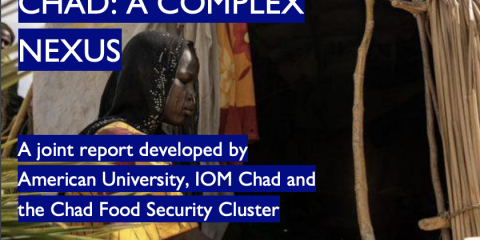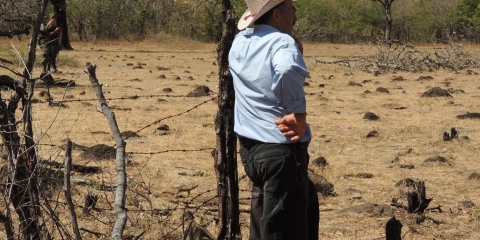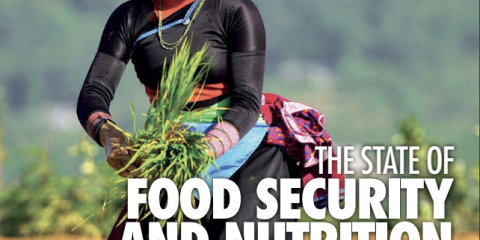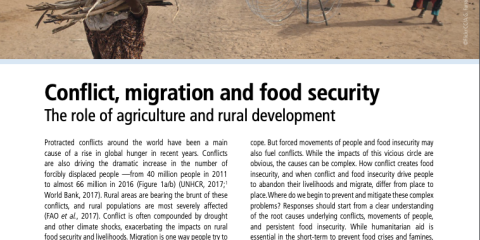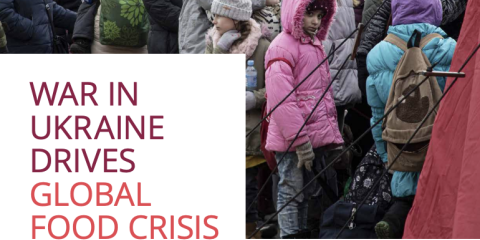
Climate change (with subsequent natural hazards and extreme weather events) and conflict are two of the key drivers of acute food insecurity.
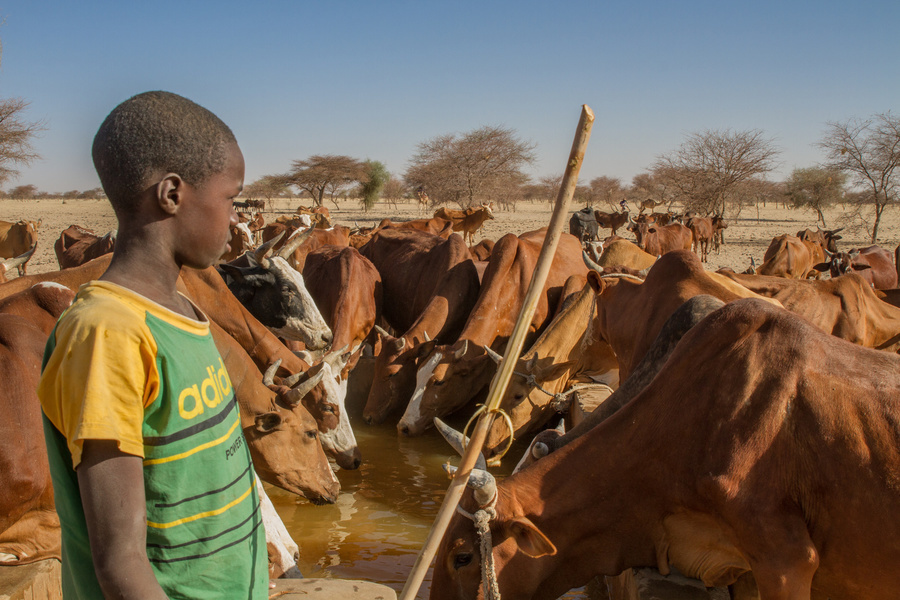
Climate Change
The Sixth Assessment Report of the Intergovernmental Panel on Climate Change (IPCC) concludes with high confidence that climate change is changing precipitation and temperature patterns and increases the frequency and severity of extreme weather events in many parts of the world, all of which affect food security by reducing agricultural production (IPCC, 2022). It reports medium confidence in the role of climate extremes as a “stress multiplier for internal and external migration” (IPCC, 2019). Future projections indicate substantial climate-related declines in agricultural productivity in coming decades across large areas (e.g., maize in Africa). People can be compelled to move seasonally to urban or other rural areas to find more sustainable food sources and alternative income. Extreme environmental conditions reduce communities’ coping capacity and affect livelihoods, causing people to move away from affected or at-risk areas. The Internal Displacement Monitoring Centre (IDMC) reported 32.6 million new internal displacements worldwide in 2022 due to disasters, the majority (31.9 million) was caused by weather-related disasters, including floods, storms, wildfires and extreme temperatures (IDMC, 2023).
However, these conditions can also have a the opposite effect, i.e. reduce already-low agricultural income to point where affected population may become immobile.
UN Secretary-General António Guterres highlighted climate change as an important factor increasing accelerating migration by making areas uninhabitable and threatening food security (UN, 2021).
A World Food Programme (WFP) analysis shows that a 2°C rise in average global temperature above pre-industrial levels may put 189 million people at risk of hunger (WFP, 2021). For a 4°C temperature rise, this figure could reach 1.8 billion (IBID).
Conflict
Conflict can be a key driver of acute food insecurity (Global Report on Food Crises, 2023). Repercussions of the war in Ukraine has had implications on food availability not only in Ukraine but globally. Ukraine and the Russian Federation are major grain exporters, accounting for 30% of global maize and wheat supplies, as well as more than half of global sunflower seed oil supplies (European Council, 2023). The Russian Federation is also one of the largest exporters of natural gas, oil and fertilisers (International Energy Agency, 2022; OECD, 2022). The war in Ukraine has affected global food and commodity prices significantly (European Council, 2023; WFP, 2023; World Bank, 2022). In March 2022, the FAO Food Price Index reached a record high, and even though it gradually decreased throughout the year, it was still significantly higher than it was prior to the pandemic. (FAO et al, 2023).
Drivers Multicausality – Data Analysis
Apart from societal and economic structures exacerbating economic inequality and poverty, the effects of conflict and climate change can compromise economic opportunities and financial security, eventually leading to food insecurity.
Migrants in East, West and Central Africa primarily move for economic reasons (IOM DJIBOUTI, 2022; IOM, 2022; IOM/RDH, 2022, IOM FLOW MONITORING, 2022; DTM, 2022). However, it is challenging to isolate the drivers of economic migration flows, which include both voluntary and forced movement. Thus, the number of people moving in the context of slow-onset environmental and climate events or as a result of conflict is not known, as people are ultimately driven by the effect that those events have on the economic situation and food security (IOM, 2021).
With four consecutive failed rainy seasons, the Horn of Africa (HoA) is facing one of its most severe droughts in at least 40 years. More than 23.5 million people are enduring high levels of acute food insecurity due to drought in Ethiopia, Kenya and Somalia (OCHA, 2023).
Droughts are exacerbating vulnerability and hampering resilience. As of June 2023, IOM’s Displacement Tracking Matrix estimates that 3 million people were displaced by drought in the Horn of Africa, and 6.6 million internally displaced persons (IDPs) were living in drought-affected areas, and approximately 238,000 migrants were moving to and from such areas (IOM, 2023a). Find more reports here.
In the context of growing resource scarcity, especially regarding climate-linked water stress and associated livelihood losses, there has been an increase in localized conflict over cattle, crowding at drying water points for livestock, and other forms of competition. The region has also been negatively impacted by deteriorating macroeconomic conditions and trade disruptions related to the war in Ukraine at a time when households continue to face the effects of the COVID-19 pandemic on livelihoods and income sources. As food prices rise in drought-affected areas, food insecurity and malnutrition increase (IOM, 2023b).
Many regions in Ethiopia are currently experiencing one of the most severe droughts in recent decades, driving substantial harvest losses and leaving more than 8 million people acutely food insecure. The death of 1.5 million livestock due to drought has further destroyed livelihoods. More than half a million drought-affected people have been displaced and migrated in search of water, pasture or assistance (ibid).
As a transit country for mostly Ethiopians, Djibouti experienced a 79 per cent increase in movement from April to June 2022 (from 8,953 Ethiopians in April to 16,050 people in June) of which 89 per cent were searching for work. While the number of entries into Djibouti remained high in July, the data shows a significant reduction of movement compared to the previous month.
Number of recorded arrivals from Ethiopians in Djibouti (Jan-Jul 2022)
Source: Own visualization based on IOM, 2022.
Reason for traveling to Djibouti in July 2022
Source: Own visualization based on IOM, 2022.
Respondents’ professional status by sex
Source: Own visualization based on IOM, 2022.
Within Djibouti, more than 134,000 people were considered food insecure as of May 2022. Especially in rural areas, people face poor or no access to markets, reduced means to buy food due to higher prices and limited access to income (IOM, 2022).
Several countries in West Africa, including as Mali, suffer from periodic droughts. Seasonal migration is used as a strategy by households and communities to diversify income during drought periods (Ionesco et al., 2017, pp. 44 and 65). Currently, the socioeconomic consequences of the COVID-19 crisis and the discovery of new gold mines are additional factors influencing the movement within Mali and Niger (IOM, 2021).
Niger is recording rising movement due to economic reasons (+6% from May to June 2022), while fewer people are travelling primarily for their studies or to attend family events. As economic pressures and food insecurity increase, people are likely to reduce non-essential travel; thus, food insecurity can lead to both a reduction and an increase in movement.
Share of people moving due to economic reasons recorded in Niger, 2021- 2022
Source: IOM Country Office Data, 2022.
Multiple context-specific drivers often work together to shape mobility decisions. The increased economic migration experienced in mid-2022 results from the interplay of food insecurity as an outcome of climate change and violent conflicts, as well as economic opportunities post Covid-19 restrictions. With this complex multicausality, it is difficult to disentangle drivers from one another, or attribute mobility to any one particular factor (IOM, 2021). People’s perceptions of conflict and disasters, the adverse effects of climate change and environmental degradation must also be accounted for, as they influence decision-making (IBID.) .
Disclaimer: This webpage curates public information and data. The opinions expressed in this webpage are those of the authors and do not necessarily reflect the views of the International Organization for Migration (IOM), nor its Member States and other stakeholders. The designations employed and the presentation of material throughout the webpage do not imply expression of any opinion or endorsement whatsoever on the part of IOM, its Member States and other stakeholders concerning the legal status of any country, territory, city or area, or of its authorities, or concerning its frontiers or boundaries. While the portal section "Food security" has been made possible with funding from the German Federal Foreign Office and the Federal Department of Foreign Affairs (FDFA) Switzerland, the contents on this section do not necessarily reflect their official policy or position.

